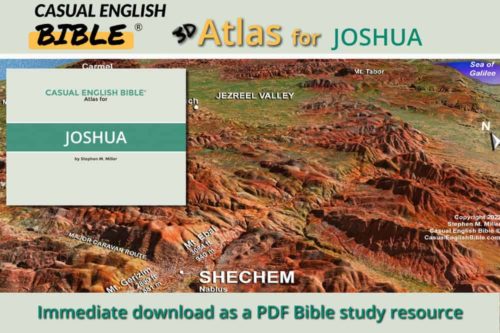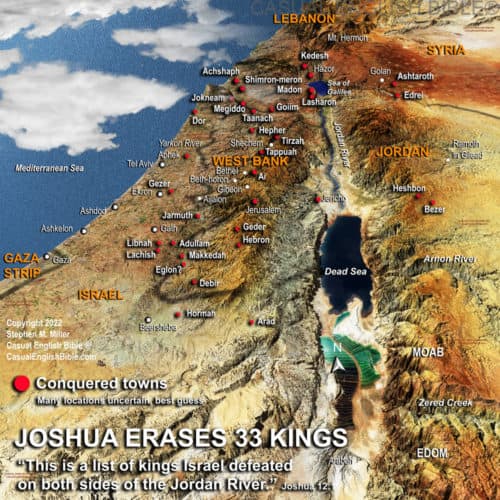Joshua 12
Israel’s list of 33 kings they killed
Two kings Moses defeated
1This is a list of kings Israel defeated on both sides of the Jordan River.East of the Jordan, they took all the land from Mount Hermon in the north to the Arnon River gorge in the south. They also took the land between the two, including the east side of the Jordan River Valley. 2They captured the land of King Sihon, an Amorite who ruled from his capital city of Heshbon. He controlled the southern part of Gilead territory. His kingdom stretched from the Arnon River gorge in the south to the Jabbok River in the north. The other side of the Jabbok was home to Ammonites. 3King Sihon also controlled the eastern side of the Jordan River Valley. This stretched from the Sea of Galilee southward along the Beth-jeshimoth Road. It ended in the Mount Pisgah [1]region at the northern tip of the Dead Sea.
4King Og of Bashan was the last of a group of people called the Rephaim. [2] He had homes in the cities of Ashtaroth and Edrei. 5He controlled land at the foot of Mount Hermon and all of western Bashan territory, clear to the boundaries of the Geshur and Maacah kingdoms. He also controlled the northern half of Gilead territory, all the way down to the kingdom of Sihon who ruled in the city of Heshbon.
6Moses, the LORD’s devoted worker, led Israel in defeating these kingdoms. He gave their conquered lands to the Israelite tribes of Reuben, Gad, and clans that made up half the tribe of Manasseh.
31 kings Joshua defeated
7This is a list of the kings Joshua and the people of Israel defeated west of the Jordan River.They conquered territory from Baal-gad in Lebanon Valley as far south as Mount Halak [3] in the west and Edom in the distant east. Joshua divided this land among tribes that hadn’t yet been assigned any territory. 8This land included the Jordan River Valley, mountains, foothills, plains, deserts, and desolate badlands. This land used to belong to Hittites, Amorites, Canaanites, Perizzites, Hivites, and Jebusites. Here’s the list of cities conquered, with their kings killed.
9Jericho, Ai (near Bethel),
10Jerusalem, Hebron,
11Jarmuth, Lachish,
12Eglon, Gezer,
13Debir, Geder,
14Hormah, Arad,
15Libnah, Adullam,
16Makkedah, Bethel,
17Tappuah, Hepher,
18Aphek, Lasharon,
19Madon, Hazor,
20Shimron-meron, Achshaph,
21Taanach, Megiddo,
22Kedesh, Jokneam on Mount Carmel,
23Dor in Naphath-Dor, Goiim in Galilee, [4]
24and Tirzah.
That totals 31 kings Joshua and the Israelites defeated.
Footnotes
Pisgah means “summit.” Mount Pisgah may refer to one or more of the high points on Moab’s plateau overlooking the Dead Sea, the Jordan River, and Canaan below, to the west. Mount Nebo is there, where Moses died. It’s the highest summit on the plateau, at 2,300 feet elevation, or 710 meters. That’s an especially good vantage point to view what is now Israel and Palestinian territories since the Dead Sea is about 1,400 feet below sea level, or 430 meters. The difference is more than a kilometer, about three-fourths of a mile.
A group of Canaanites living mainly along the borders of what are now Israel, Occupied Palestinian Territories, Syria, and Jordan.
Today called Jebel Halaq, it’s southeast of Beersheba, about a two-day walk south of Jerusalem, roughly 40 miles (64 km).
One ancient copy of Joshua calls this town Gilgal.
Discussion Questions
- Sorry, there are currently no questions for this chapter.






